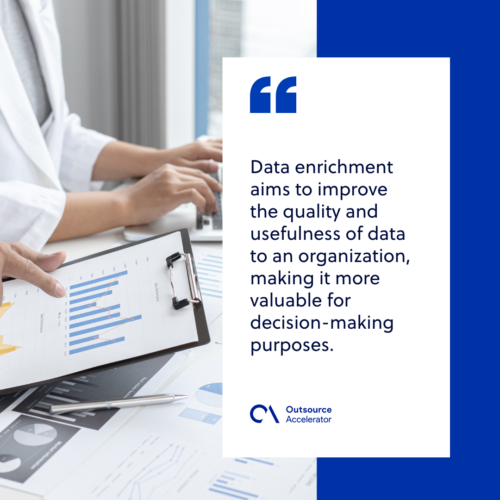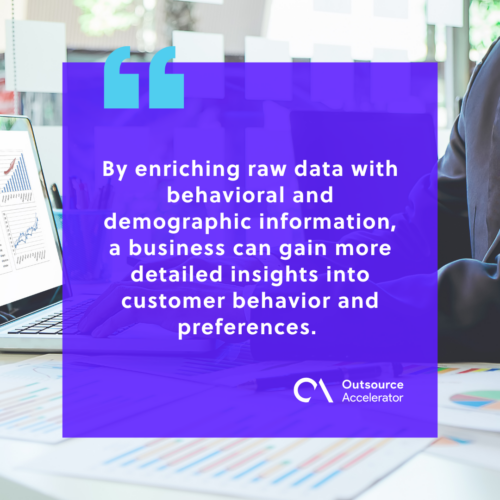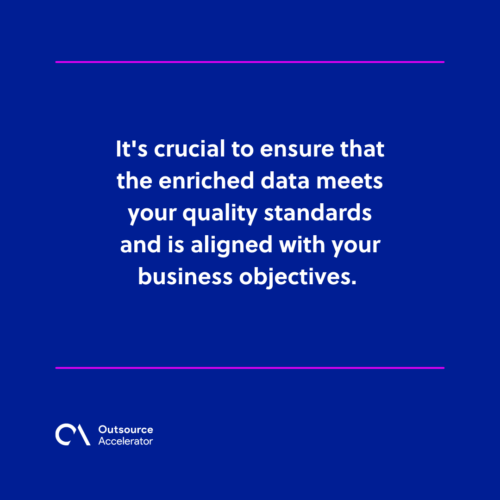The power of data enrichment: Improving your business insights

In today’s data-driven world, businesses are constantly looking for ways to improve their decision-making processes and gain a competitive edge.
Imagine having access to the same data as your competitors — it makes standing out much more difficult.
One way to edge out the competition is through data enrichment. Data enrichment is a solution that can turn the information your enterprise possesses into a valuable asset.
In this article, we’ll explore data enrichment, its different types, its advantages, and how to implement it effectively in your business.
Defining data enrichment
Data enrichment enhances raw data (aka first-party data) collected from internal sources with additional information from other internal or external sources.
This is done to obtain more context and insights.
This process can involve adding new data fields, such as demographic or geographic information, or enriching existing fields by asking for more detailed information.
Data enrichment aims to improve the quality and usefulness of data to an organization, making it more valuable for decision-making purposes.
Data enrichment vs. Data cleansing
It’s important to note that data enrichment is not the same as data cleansing — which involves identifying and correcting errors or inconsistencies in raw data.
While data cleansing is an important step in preparing data for analysis, data enrichment takes it a step further by adding additional information to enhance the data’s value.
Ultimately, both processes are crucial for maintaining a high-quality database.

3 common types of data enrichment
There are several types of data enrichment, each of which provides different types of information to enhance raw data.
Here are the most common types of data enrichment:
1. Behavioral
Behavioral data enrichment involves adding information about how users interact with your products or services.
It focuses on capturing and analyzing user actions, interactions, and patterns. This can include data on:
- Website browsing behavior
- Website visits
- Click-through rates
- Purchase history
- Social media engagement
By enriching raw data with behavioral information, you can gain insights into customer preferences and behavior.
In turn, it can inform marketing and product development strategies that result in more personalized marketing campaigns and improved customer experience.
It also grants businesses the ability to make data-driven business decisions.
2. Demographic
Demographic data enrichment adds census-related, statistical information to your existing dataset or database.
Demographic information includes attributes such as:
- Age
- Gender
- Income level
- Occupation
- Education
- Marital status
This type of data can be particularly useful for businesses that want to target specific customer segments.
By enriching your data with demographic details, you can better understand your target audience and segment your customer base.
Plus, you can tailor your products or services to specific demographics.
3. Geographic
Geographic data enrichment involves appending location-based information to your data collection and archive. This includes details like:
- Zip codes
- Addresses
- Latitude and longitude coordinates
- Regional demographics of users or customers
This data can be useful for enterprises that want to target potential clients in specific geographic areas.
By incorporating geographic data, you can analyze regional preferences, target local markets, optimize logistics, and customize marketing campaigns based on location-specific insights.
Advantages of data enrichment
Data enrichment offers several advantages that can significantly impact your organization’s operations and decision-making processes.
Some of the key benefits of data enrichment include:
More detailed insights into customer behavior and preferences
By enriching raw data with behavioral and demographic information, a business can gain more detailed insights into customer behavior and preferences.
This can inform marketing and product development strategies, helping businesses better meet the needs of their customers.
In order to gain a better understanding of customer behavior and preferences, it is essential to utilize customer nurturing data enrichment.
Improved accuracy and completeness of data
Data enrichment can improve data quality by filling in missing information, correcting errors, and removing duplicates.
By enriching raw data with additional information, companies can fill in gaps and provide a more accurate and reliable representation of their business metrics.
It enables them to make data-driven decisions confidently.
Implementing strategies like regular data validation, standardized data entry protocols, and the use of advanced tools can greatly enrich data quality.
Enhanced targeting and personalization
By using enriched data to target specific customer segments, businesses can create more personalized marketing campaigns and product offerings.
This can lead to higher customer engagement, conversion rates, customer loyalty, and retention.
Several notable pieces of research show the importance of personalized customer experience with the help of data enrichment:
- According to Salesforce, 66% of consumers expect brands to meet and understand their individualistic needs and expectations.
- The same study conducted by Salesforce also revealed that 52% of consumers want all brand offers to be personalized.
- As per Shopify, 54% of buyers claim they like to view products physically in the store and then buy them online (or vice-versa). More so, 53% of businesses are looking into adopting omnichannel strategies to cater to consumer behavior.
By leveraging customer data effectively, businesses can tailor their offerings to meet the specific needs and preferences of their target audience.
Through the power of a data enrichment tool, businesses can fine-tune their marketing efforts, delivering content that resonates with individuals on a more personal level, ultimately driving business growth and success.
Increased efficiency and cost savings
Data enrichment can be used to inform the decision-making process better, making it more efficient.
As a result, a firm can save a lot of time and resources by avoiding making costly mistakes or missteps.
By examining various data points, such as production output, resource utilization, and operational expenses, businesses can identify areas for improvement.
Enhanced predictive analytics
Data enrichment can help enterprises improve their predictive analytics capabilities by providing detailed and accurate data.
By using enriched data to train machine learning models, businesses can make more accurate predictions about consumer behavior and preferences.
This innovative technique empowers organizations to extract valuable insights and make informed decisions that lead to success using existing data.
Better risk management
Enriched data can help businesses identify and mitigate risks more effectively by providing more detailed insights into customer behavior and market trends.
It makes room for an improved system of risk management.

Implementing data enrichment in your business
Implementing data enrichment in your organization can seem daunting, but it doesn’t have to be.
Here are some steps you can take to get started with the data enrichment process:
Define your data enrichment goals
Start by clearly defining your objectives and identifying the specific insights or outcomes you aim to achieve through data enrichment.
This could include improving customer segmentation, enhancing personalization efforts, optimizing marketing campaigns, or gaining a better understanding of your target audience.
Defining your goals will help you prioritize and focus your data enrichment efforts.
Identify reliable data sources
Once you have defined your goals, it’s important to identify reliable external data sources that can provide the additional information you need.
Look for reputable, accurate, relevant sources for your industry or target audience. These sources include public records, government databases, industry reports, customer surveys, social media data, or third-party data providers.
Ensure the data sources comply with data protection regulations and meet your business requirements.
Assess data quality and accuracy
Before integrating external data into your dataset, assess the quality and accuracy of the data.
Verify the reliability of the data sources and evaluate the relevance and completeness of the information they provide.
It’s crucial to ensure that the enriched data meets your quality standards and is aligned with your business objectives.
Inaccurate or low-quality data can lead to erroneous insights and flawed decision-making.

Develop data integration processes
Establish robust processes for integrating the enriched data with your existing dataset. This may involve using data integration tools, Application Programming Interfaces (APIs), or working with data experts.
Based on your infrastructure, technical capabilities, and the volume and complexity of the data, determine the most suitable method for integrating it.
The integration process should be efficient, secure, and scalable to accommodate future data enrichment requirements.
Ensure compliance with data protection regulations
As you work with external data sources, prioritize data privacy and compliance.
Ensure that the data acquisition and integration processes adhere to relevant data protection regulations, such as:
- General Data Protection Regulation (GDPR)
- California Consumer Privacy Act (CCPA)
Protecting the privacy of your customers’ data is essential for building trust and maintaining regulatory compliance.
Continuously monitor and update enriched data
Enriched data is not a one-time process; it requires ongoing maintenance and updates.
Monitor the external data sources regularly to identify any changes or updates that may affect the accuracy or relevance of the enriched data.
Establish processes to ensure the enriched data is regularly refreshed and synchronized with the external sources.
This will help you maintain data accuracy and maximize the value of the enriched dataset over time.
Leverage data analysis and insights
Once the enriched data is integrated into your dataset, leverage data analysis tools and techniques to extract meaningful insights.
Explore the enriched dataset to uncover patterns, trends, and correlations that can drive actionable insights and inform decision-making.
Use data visualization techniques to communicate these insights effectively to stakeholders and make informed business decisions based on the enriched data.
You can take advantage of data enrichment tools that collect, organize, and clean up data and format it in a useful way for your business.
Using more than one tool to carry out the data enrichment process is common since some have specific functions.
Implementing data enrichment in your business can unlock valuable insights, enhance decision-making, and drive better business outcomes.
By following the steps outlined, you can effectively integrate external data sources, ensure data quality and compliance, and continuously update and leverage the enriched data for strategic advantage.
Data enrichment is a powerful tool for better understanding your customers, improving targeting and segmentation, and staying ahead in today’s data-driven business landscape.







 Independent
Independent




